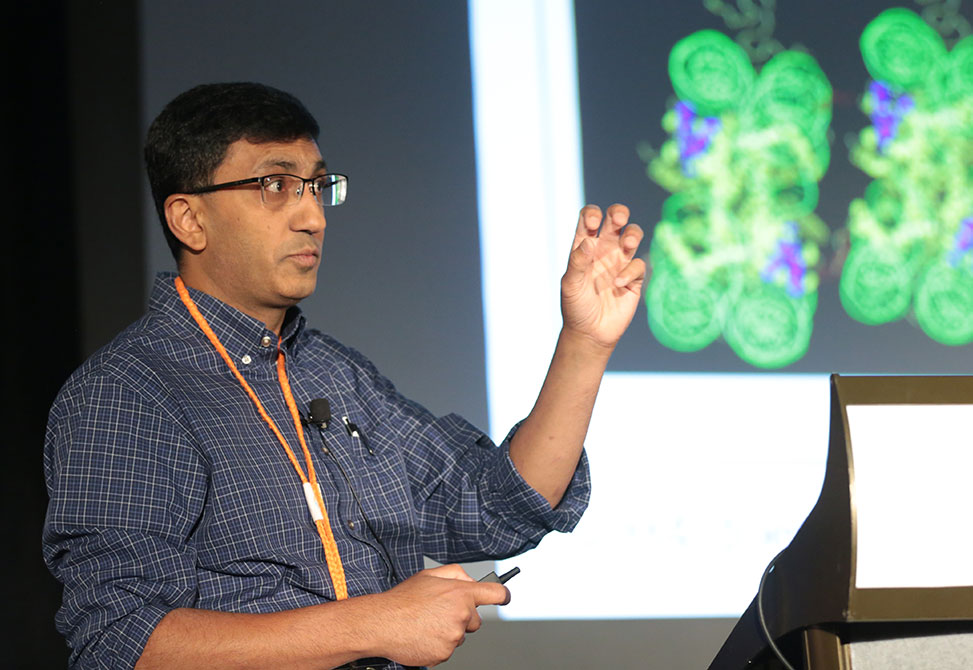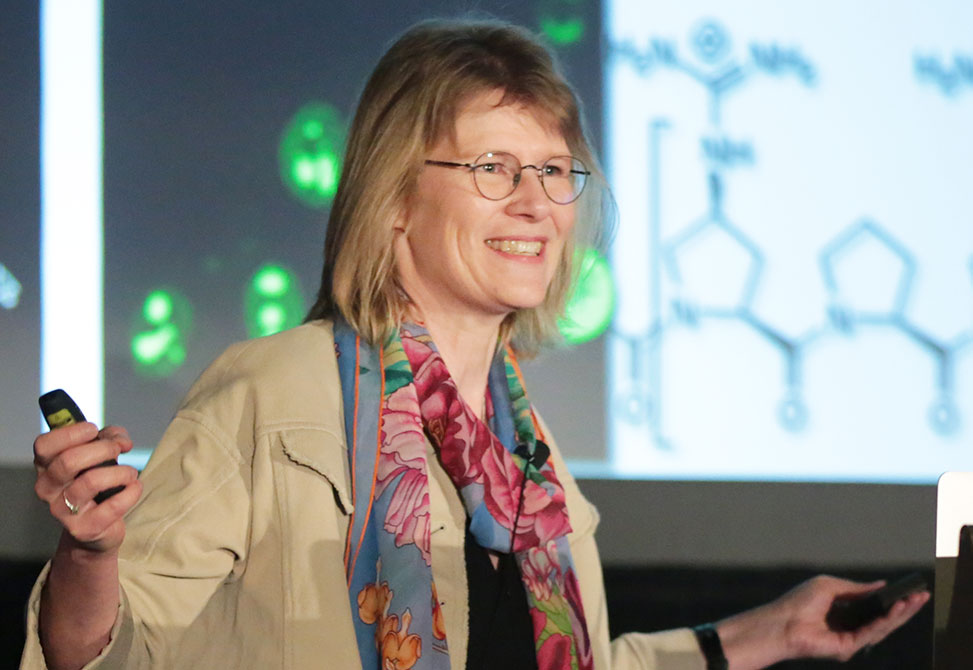Presentations Chronological Order
L01 | Kiessling

Blueprints are needed to generate agents that alter immune responses, vaccines or tolerizing agents. The design principles have been elusive because many immune system receptors can...
Read More…L02 | Becker

At least 50% of all human proteins are predicted to experience one or more posttranslational modification, PTM, during their life cycle. These PTMs can result from enzymatic...
Read More…L03 | Cheloha

Peptides and antibodies represent two leading modalities for targeting protein receptors expressed on the surface of mammalian cells. Endogenous peptides often serve as leads for...
Read More…L04 | Sawyer

Polyproline II helices are ubiquitous structures in proteins with significant enrichment in both structural proteins, for example, collagen, and as ligands for modular protein-protein...
Read More…L05 | Bong

We introduce herein a new peptide-based strategy for intracellular RNA and DNA tracking that is robust, orthogonal, and complementary to existing methods: Fluorogenic U-Rich Internal...
Read More…L06 | Fuller

Sequence-specific, monodisperse peptoids, N-substituted glycine oligomers, have found diverse utility in biological and materials applications. A foundational understanding of residues that...
Read More…L07 | Chatterjee

The small ubiquitin-like modifier protein, SUMO, is found in all eukaryotic organisms where it plays key roles in regulating protein conformation, localization, and function. Enzymatic...
Read More…L08 | David

Cellular proteins continuously undergo non-enzymatic covalent modifications, NECMs, which alter protein structure, function, stability and binding-partner affinity. These chemical...
Read More…L09 | Distefano

Protein lipid-modification involves the attachment of hydrophobic groups to polypeptides within cells after they are synthesized by ribosomes. The purpose of these modifications is to...
Read More…L10 - YI1 | Adams

Extended amino acid backbone conformations are an abundant structural motif responsible for mediating a myriad of protein-protein interactions, PPIs. Yet, the shallow protein...
Read More…L11 - AW | Chou

Side effects from medicine often limit the therapeutic window and reduce overall clinical benefits. Approaches that can minimize side effects while maintaining therapeutic efficacies...
Read More…L12 | Grossmann

The inhibition of disease-relevant protein-protein interactions, PPI, represents an appealing strategy towards the development of novel therapeutics. Due to the extended nature...
Read More…L13 | Qvit

Mitochondria are maternally inherited, cytoplasmic organelles that play central roles in maintaining cellular metabolic homeostasis, cell survival, and cell death. They are also the so-called "powerhouses"...
Read More…L14 | Sereikaite

Neuronal function is dependent on tightly regulated processes and a fine-tuned balance of synaptic excitation and inhibition. γ-Amino butyric acid, GABA, is the primary...
Read More…L15 | Kennedy

The Leucine-Rich-Repeat-Kinase-2, LRRK2, protein is a multi-domain protein and missense mutations along the different domains of LRRK2 are the most common cause of genetically...
Read More…L16 - YI2 | Emenike

One of the ways through which nature increases the functional diversity of the proteome is through a process known as posttranslational modifications, PTMs. Dimethylation of lysine...
Read More…L17 - AW | Gellman

The ribosome, aided by supporting actors such as tRNA synthetases, is the star of an extraordinary molecular spectacle. However, the chemist can imagine many constituents...
Read More…L18 | Raines

Cysteine and methionine are relatively rare residues that are well known for their susceptibility to oxidation by reactive oxygen species, ROS. Histidine is the most common...
Read More…L19 | Watson

Selenium provides unique opportunities in the chemical synthesis and modification of proteins owing to its enhanced reactivity compared to corresponding sulfur-containing...
Read More…L20 | VanVeller

The prevalence of post-translational modification in nature suggests that expanding beyond the suite of functional groups found in the 20 canonical amino acids can impart...
Read More…L21 | Rubini

The cis/trans isomerization of peptidyl-prolyl peptide bonds is an intrinsically slow reaction that significantly slows down the folding process in proteins that contain...
Read More…L22 | Cai

The identification and development of sequence-specific peptidomimetics is of significance in bioorganic chemistry and chemical biology. A new class of peptidomimetics termed...
Read More…L23 | Alabi

PROTACs have been shown to selectively induce the degradation of a wide range of intracellular proteins. By employing a ligand that recruits an E3 ubiquitin ligase and another...
Read More…L24 | Medina

Macrophages are specialized phagocytes that play central roles in immunity and tissue repair. Their diverse functionalities have led to an evolution of new allogenic and autologous...
Read More…L25 | Ghirlanda

Membraneless organelles are widespread in biology, and their role in supporting cellular function is increasingly recognized. They form by liquid-liquid phase separation...
Read More…L26 | Futaki

We previously reported an attenuated cationic amphiphilic lytic, ACAL, peptide, engineered from a natural hemolytic peptide, named L17E.1 Substantial cytosolic delivery...
Read More…L27 - AW | de la Fuente

Artificial intelligence, AI, has the potential to outperform humans and revolutionize our world. In this talk, I will describe our efforts using AI to develop computational approaches for antibiotic...
Read More…L27 - AW | Malins

The use of electricity to drive chemical reactions is an appealing approach to green and sustainable synthesis. Moreover, electrochemistry provides powerful opportunities...
Read More…L28 | Duggal

With advances in peptide screening technologies and strides in medicinal chemistry synthetic technologies, the ability of peptides to expand the druggable proteome is apparent. The path...
Read More…L29 | Castanho

We are developing drugs able to inactivate Zika virus, Dengue virus, HIV, and SARS-CoV-2, among others, while having the ability to traverse the blood-brain and blood-placenta barriers...
Read More…L30 | Qu

With an increasing prevalence of obesity, there is a need for new therapies to improve body weight management and metabolic health. Multi-receptor agonists in development...
Read More…L31 | Brunel

Obesity is endemic throughout much of the world and obesity-related morbidities include heart disease, stroke, non-alcoholic steatohepatitis, NASH, and type 2 diabetes...
Read More…L32 - YI3 | Schissel

Peptide-mediated delivery of macromolecules in cells has significant potential therapeutic benefits, but no therapy employing cell-penetrating peptides, CPPs, has reached...
Read More…L33 - YI4 | Sharma

Endogenous bioactive peptides, for example, neuropeptides and peptide hormones, are a class of signaling molecules that play pivotal roles in maintaining cardiovascular...
Read More…L34 - AW | Tam

A continuing challenge in discovery of peptide therapeutics from natural products is to find a new paradigm that target intracellular protein-protein interactions...
Read More…L36 | Roberts

Residue-selective methods for the modification and cyclization of peptides are useful for the discovery and development of therapeutic peptide leads with metabolically stable...
Read More…L37 | Nitsche

Constrained and modified peptides fill an underexplored area of chemical space between small molecule therapies and larger antibodies. Noncanonical modifications...
Read More…L38 | Schroeder

Tyrosyl-DNA phosphodiesterase 1, TDP1, is a molecular target for the sensitization of cancer cells to the FDA-approved topoisomerase inhibitors topotecan and irinotecan...
Read More…L39 | Yudin

Favorable drug-like properties is a fundamental challenge in the development of bioactive macrocycles. To achieve this objective, chemists have resorted to various...
Read More…L40 - YI5 | Rössler

Encoded libraries of small molecules have vastly accelerated drug discovery. Most prominently, DNA-encoded libraries have found widespread success and adaption...
Read More…L41 - YI6 | Martinez-Valdivia

Dysregulation in the protein-protein interactions, PPIs, of transcriptional components, such as coactivators and activators, profoundly affects gene expression and is prominent...
Read More…L42 | van der Donk

The genome sequencing efforts of the past 20 years have revealed that ribosomally synthesized and post-translationally modified peptides, RiPPs, constitute...
Read More…L43 | Parkinson

Natural products, NPs, are a bountiful source of medicines, agricultural products, and chemical tools. Bioinformatics data suggest hundreds-of-thousands of novel...
Read More…L44 | Neundorf

Collagen is the most abundant protein in mammals and not surprisingly, dysregulated collagen homeostasis is related to different pathologic conditions. Extensive fibrosis...
Read More…L45 | Nag

Antibodies, due to their high affinity and selectivity for epitopes on antigens have extensive use as therapeutics reagents, but their large sizes preclude them from being effective...
Read More…L47 | Stockdill

Peptides are important lead targets for pharmaceutical and vaccine development, but traditional methods for their synthesis, especially on an industrial scale, are problematic...
Read More…L48 | Mitchell

The diverse array of chemical functionality displayed by the 20 canonical amino acids presents both challenges and opportunities for the site-selective modification of peptides and...
Read More…L49 | de la Torre

Although SPPS is the method of choice for synthesis of peptides in both research and industrial modes, it could be interpreted as a black box. This creates an important...
Read More…L50 | Hartrampf

Solid-phase peptide synthesis, SPPS, has been a standard method for chemical protein production for the past 60 years, but its outcome can be highly dependent on the...
Read More…L51 - YI7 | Smith

The synthesis of amino acid glycosides has been an ongoing synthetic challenge. Glycosylation of peptides has been shown to be an important way to enhance stability and transport...
Read More…L52 | Tirrell

Vascular disease is a leading cause of morbidity and mortality in the United States and globally. Pathological vascular remodeling, such as atherosclerosis and...
Read More…L53 | Knight

Composed of only twenty amino acids, proteins offer complex functions and impressive binding capabilities. Synthetic polymers offer an expansive monomer scope yielding tunable chemical...
Read More…L54 | Gomes

"Clicking" Peptides to Biomaterials and to Ionic Liquids: Towards Dual-Action Topical Formulations for Skin and Soft Tissue Infections...
Read More…L55 - AW | Wennemers

Collagen, the most abundant protein in mammals, is a key contributor to the strength and stability of skin, bones, and connective tissue. Collagen formation is thus vital for...
Read More…L56 | Hecht

Several strategies now exist for the ribosomal synthesis of peptides and proteins containing non-proteinogenic amino acids. These enable the incorporation of...
Read More…L57 | Soloveychik

SyntheX created empirical drug discovery platforms to discover protein interaction modulators. ToRPPIDO to allow for the discovery of compounds that can disrupt a specific...
Read More…L58 | Tucker

Proprotein convertase subtilisin-like/Kexin type 9, PCSK9, is a clinically well-validated and critically important target for treating high LDL-cholesterol and potential coronary...
Read More…L59 | Ye

Cyclic peptides are diverse molecules that are now a focus in drug discovery efforts. Their molecular size, between small molecules and biologics, provides attractive...
Read More…L60 - YI8 | Nielsen

Small cyclic peptides provide an attractive modality for drug development due to their ability to bind challenging targets and their potential to cross membranes for reaching...
Read More…L61 - AW | Waters

Post-translational modifications, PTMs, in histone proteins, including lysine methylation and acylation, regulate gene expression through recruitment of reader proteins to the...
Read More…L62 | DeGrado

Not too long ago, the design of proteins from scratch that fold into predictable structure was considered an impossible task, but it is now increasing routine. Given our ability to design...
Read More…L63 | Cai

It has been widely accepted that using peptide-based molecules to disrupt protein-protein interactions is a promising strategy to address some disease targets, especially those that are...
Read More…L64 | Jumper

Modern protein structure prediction via AlphaFold and related methods has shown a remarkable ability of machine learning methods to learn chemical and evolutionary principles...
Read More…L65 | Hall

We describe our efforts to develop an efficient computational algorithm that searches for peptides that bind strongly and selectively to specific biomolecular targets...
Read More…L66 | Akinsaya

Designing therapeutic peptides that adhere to a range of target product profile criteria is a multiparameter optimization, MPO, problem that is challenging to solve...
Read More…L67 | Price

Machine learning language models have mastered human dialect; models like GPT-2, GPT-3, and the ChatGPT can write sophisticated realistic responses to simple prompts...
Read More…L68 | Bhardwaj

Machine learning, ML, methods have demonstrated tremendous success in the structure prediction and design of larger proteins.1, 2 However, these established methods...
Read More…L70 | Kay

D-peptides are promising therapeutic agents because of their resistance to proteases and low immunogenicity. However, D-peptide discovery using high-throughput screening methods...
Read More…L71 | Jongkees

The current Covid-19 pandemic dramatically illustrates the need to find new anti-viral agents, and underscores the importance of finding these agents before they are needed...
Read More…L72 | Dang

Direct site-specific methods of chemical protein functionalization are highly desirable. However, such methods are particularly challenging to develop due to the tremendous difficulty of...
Read More…L73 | Rodriguez

Electron diffraction has historically played an important role in the advancement of crystallographic approaches for the determination of complex small molecule structures...
Read More…L74 | Burslem

The proteins of class I major histocompatibility complex, MHC-I, display epitopic peptides on the cell surface, providing the foundation for immune surveillance of intracellular threats...
Read More…L75 | Tucker

2D IR vibrational probe pairs provide structural maps for uncovering dynamics associated with active biomolecules, providing insights into the molecular movements leading...
Read More…L76 | Wells

The cell surface proteome, the surfaceome, is a major hub for cellular communication and a primary source of drug targets, especially for biologics. Identifying how...
Read More…

